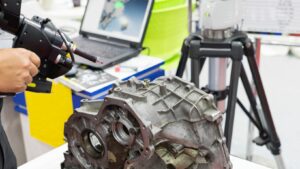In the symphony of innovation, few fields hit as high a note as automotive engineering. It’s the perfect blend of creativity and technical acumen, where science meets art in the pursuit of speed, safety, and sustainability. This field, ever-evolving, is the beating heart of the automobile industry, driving us towards a future that’s cleaner, safer, and more efficient.
Engines purr, tires screech, and designs dazzle — but what’s under the hood? From the intricacies of hybrid technology to the marvels of autonomous driving, automotive engineering is a complex, captivating world. So, buckle up and get ready for a deep dive into the dynamic, fast-paced universe of automotive engineering.
Automotive Engineering
Delving into the automotive engineering realm reveals an intertwining of creativity, technical expertise, and an unwavering drive towards a cleaner and efficient future. This section takes an in-depth look into the history and evolution of this intriguing field and discusses some key principles vital to its functioning.
History and Evolution
 Dating back to the 18th century, automotive engineering sprang from the invention of the first self-propelled road vehicle. This steam-powered device, devised by Nicolas-Joseph Cugnot, was the forerunner of today’s cars. Over the centuries, automotive technology took significant strides. In 1886, Karl Benz patented his “Motorwagen”, heralding the arrival of the first gasoline-powered automobile. Moving into the 20th century, vastly improved technologies reshaped the automotive landscape, leading to the birth of hybrid vehicles, electric cars, and ultimately, autonomous vehicles.
Dating back to the 18th century, automotive engineering sprang from the invention of the first self-propelled road vehicle. This steam-powered device, devised by Nicolas-Joseph Cugnot, was the forerunner of today’s cars. Over the centuries, automotive technology took significant strides. In 1886, Karl Benz patented his “Motorwagen”, heralding the arrival of the first gasoline-powered automobile. Moving into the 20th century, vastly improved technologies reshaped the automotive landscape, leading to the birth of hybrid vehicles, electric cars, and ultimately, autonomous vehicles.
Key Principles and Concepts
At the heart of automotive engineering lie a few key principles. Firstly, there’s the application of mechanical engineering, which deals with the design, manufacturing, and operation of the automobile’s mechanical systems. Next comes electrical engineering, crucial for managing the intricate wiring, sensor technology, and overall electrical operations in a vehicle. Lastly, computer engineering comes into play with the rapid advent of autonomous driving and connected vehicles, leveraging advanced software and hardware components to ensure seamless operation. These principles guide the operation of even the most sophisticated automotive systems, underpinning the creation of safe, efficient machines renowned for their speed and sustainability.
Major Fields in Automotive Engineering
In the intricate landscape of automotive engineering, certain fields stand out as pivotal components. They epitomize specialized areas that combine principles and advancements in mechanical, electrical, and computer engineering.
Vehicle Electronics
 An integral part of automotive engineering, vehicle electronics encapsulates creating and integrating electronic systems into vehicles. These systems, including control units, sensors, and actuators, dictate the functionality and efficiency of vehicles. The field focuses on improving safety, enhancing passenger comfort, and promoting sustainable practices. For instance, Anti-lock Braking Systems (ABS) and Electronic Stability Control (ESC) systems augment safety, whereas automated climate control systems enhance comfort.
An integral part of automotive engineering, vehicle electronics encapsulates creating and integrating electronic systems into vehicles. These systems, including control units, sensors, and actuators, dictate the functionality and efficiency of vehicles. The field focuses on improving safety, enhancing passenger comfort, and promoting sustainable practices. For instance, Anti-lock Braking Systems (ABS) and Electronic Stability Control (ESC) systems augment safety, whereas automated climate control systems enhance comfort.
Powertrain Engineering
Powertrain Engineering, another cornerstone in automotive engineering, focuses on designing, testing, and producing the components that propel vehicles. These components include the engine, transmission, drive shafts, and differentials. Moreover, powertrain engineering also encapsulates the integration of modern technologies such as hybrid systems and electric propulsion systems. For example, in a conventional combustion engine vehicle, powertrain engineering centers around the efficiency and reliability of the engine and transmission.
Challenges Facing Automotive Engineers
Navigating the world of automotive engineering poses several distinct challenges that revolve around environmental demands, regulatory landscapes, technological advancements, and intricate design specifics.
Environmental and Regulatory Pressures
 The automotive engineering sector grapples with increasing environmental, regulatory factors. Engineers navigate these challenges by constantly adapting, incorporating environmentally-conscious practices into their designs. For instance, regulations surrounding emissions standards demand continuous evolution of combustion engines towards cleaner energy sources. Additionally, the mandate for the incorporation of sustainable materials in car manufacture underscores the necessity of innovation.
The automotive engineering sector grapples with increasing environmental, regulatory factors. Engineers navigate these challenges by constantly adapting, incorporating environmentally-conscious practices into their designs. For instance, regulations surrounding emissions standards demand continuous evolution of combustion engines towards cleaner energy sources. Additionally, the mandate for the incorporation of sustainable materials in car manufacture underscores the necessity of innovation.
Technological and Design Complexities
Bracing against the tide of rapid technological change represents another challenge facing engineers. The advent of autonomous and connected vehicles, for example, pushes engineers towards mastering new skillsets whilst maintaining proficiency in traditional automotive mechanics. Design complexities follow suit, where demands for more electrification, lightweight vehicles, and innovative security features necessitate the integration of multi-disciplinary engineering principles. The development of a lightweight, computationally proficient, and electrically efficient vehicle system, such as for Tesla’s Model S, depicts the intersection of electrical, mechanical, and computer engineering realms, and underscores the complexities of contemporary automotive design standards.



